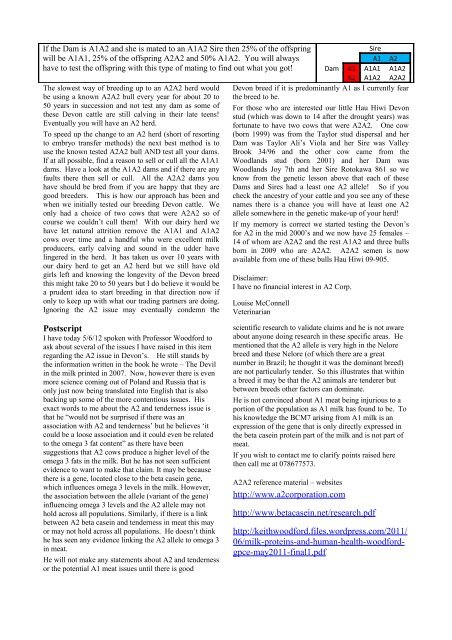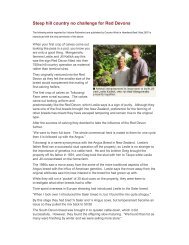Members List - NZ RED DEVON CATTLE BREEDERS ASSOCIATION
Members List - NZ RED DEVON CATTLE BREEDERS ASSOCIATION
Members List - NZ RED DEVON CATTLE BREEDERS ASSOCIATION
Create successful ePaper yourself
Turn your PDF publications into a flip-book with our unique Google optimized e-Paper software.
If the Dam is A1A2 and she is mated to an A1A2 Sire then 25% of the offspring<br />
will be A1A1, 25% of the offspring A2A2 and 50% A1A2. You will always<br />
have to test the offspring with this type of mating to find out what you got!<br />
The slowest way of breeding up to an A2A2 herd would<br />
be using a known A2A2 bull every year for about 20 to<br />
50 years in succession and not test any dam as some of<br />
these Devon cattle are still calving in their late teens!<br />
Eventually you will have an A2 herd.<br />
To speed up the change to an A2 herd (short of resorting<br />
to embryo transfer methods) the next best method is to<br />
use the known tested A2A2 bull AND test all your dams.<br />
If at all possible, find a reason to sell or cull all the A1A1<br />
dams. Have a look at the A1A2 dams and if there are any<br />
faults there then sell or cull. All the A2A2 dams you<br />
have should be bred from if you are happy that they are<br />
good breeders. This is how our approach has been and<br />
when we initially tested our breeding Devon cattle. We<br />
only had a choice of two cows that were A2A2 so of<br />
course we couldn’t cull them! With our dairy herd we<br />
have let natural attrition remove the A1A1 and A1A2<br />
cows over time and a handful who were excellent milk<br />
producers, early calving and sound in the udder have<br />
lingered in the herd. It has taken us over 10 years with<br />
our dairy herd to get an A2 herd but we still have old<br />
girls left and knowing the longevity of the Devon breed<br />
this might take 20 to 50 years but I do believe it would be<br />
a prudent idea to start breeding in that direction now if<br />
only to keep up with what our trading partners are doing.<br />
Ignoring the A2 issue may eventually condemn the<br />
Postscript<br />
I have today 5/6/12 spoken with Professor Woodford to<br />
ask about several of the issues I have raised in this item<br />
regarding the A2 issue in Devon’s. He still stands by<br />
the information written in the book he wrote – The Devil<br />
in the milk printed in 2007. Now, however there is even<br />
more science coming out of Poland and Russia that is<br />
only just now being translated into English that is also<br />
backing up some of the more contentious issues. His<br />
exact words to me about the A2 and tenderness issue is<br />
that he “would not be surprised if there was an<br />
association with A2 and tenderness’ but he believes ‘it<br />
could be a loose association and it could even be related<br />
to the omega 3 fat content” as there have been<br />
suggestions that A2 cows produce a higher level of the<br />
omega 3 fats in the milk. But he has not seen sufficient<br />
evidence to want to make that claim. It may be because<br />
there is a gene, located close to the beta casein gene,<br />
which influences omega 3 levels in the milk. However,<br />
the association between the allele (variant of the gene)<br />
influencing omega 3 levels and the A2 allele may not<br />
hold across all populations. Similarly, if there is a link<br />
between A2 beta casein and tenderness in meat this may<br />
or may not hold across all populations. He doesn’t think<br />
he has seen any evidence linking the A2 allele to omega 3<br />
in meat.<br />
He will not make any statements about A2 and tenderness<br />
or the potential A1 meat issues until there is good<br />
Sire<br />
A1 A2<br />
Dam A1 A1A1 A1A2<br />
A2 A1A2 A2A2<br />
Devon breed if it is predominantly A1 as I currently fear<br />
the breed to be.<br />
For those who are interested our little Hau Hiwi Devon<br />
stud (which was down to 14 after the drought years) was<br />
fortunate to have two cows that were A2A2. One cow<br />
(born 1999) was from the Taylor stud dispersal and her<br />
Dam was Taylor Ali’s Viola and her Sire was Valley<br />
Brook 34/96 and the other cow came from the<br />
Woodlands stud (born 2001) and her Dam was<br />
Woodlands Joy 7th and her Sire Rotokawa 861 so we<br />
know from the genetic lesson above that each of these<br />
Dams and Sires had a least one A2 allele! So if you<br />
check the ancestry of your cattle and you see any of these<br />
names there is a chance you will have at least one A2<br />
allele somewhere in the genetic make-up of your herd!<br />
If my memory is correct we started testing the Devon’s<br />
for A2 in the mid 2000’s and we now have 25 females –<br />
14 of whom are A2A2 and the rest A1A2 and three bulls<br />
born in 2009 who are A2A2. A2A2 semen is now<br />
available from one of these bulls Hau Hiwi 09-905.<br />
Disclaimer:<br />
I have no financial interest in A2 Corp.<br />
Louise McConnell<br />
Veterinarian<br />
scientific research to validate claims and he is not aware<br />
about anyone doing research in these specific areas. He<br />
mentioned that the A2 allele is very high in the Nelore<br />
breed and these Nelore (of which there are a great<br />
number in Brazil; he thought it was the dominant breed)<br />
are not particularly tender. So this illustrates that within<br />
a breed it may be that the A2 animals are tenderer but<br />
between breeds other factors can dominate.<br />
He is not convinced about A1 meat being injurious to a<br />
portion of the population as A1 milk has found to be. To<br />
his knowledge the BCM7 arising from A1 milk is an<br />
expression of the gene that is only directly expressed in<br />
the beta casein protein part of the milk and is not part of<br />
meat.<br />
If you wish to contact me to clarify points raised here<br />
then call me at 078677573.<br />
A2A2 reference material – websites<br />
http://www.a2corporation.com<br />
http://www.betacasein.net/research.pdf<br />
http://keithwoodford.files.wordpress.com/2011/<br />
06/milk-proteins-and-human-health-woodfordgpce-may2011-final1.pdf




